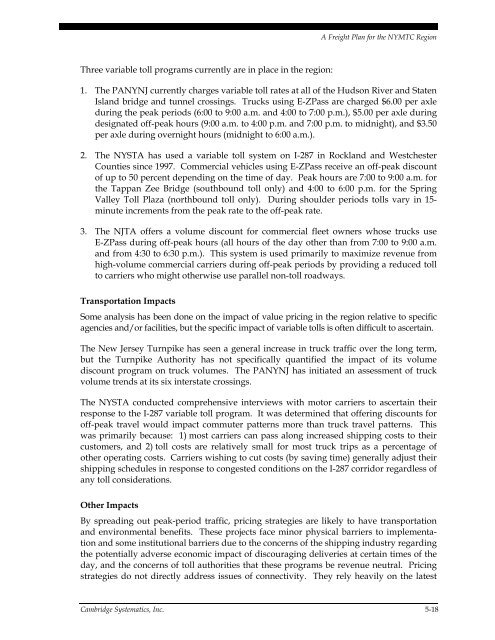nymtc regional freight plan - New York Metropolitan Transportation ...
nymtc regional freight plan - New York Metropolitan Transportation ...
nymtc regional freight plan - New York Metropolitan Transportation ...
Create successful ePaper yourself
Turn your PDF publications into a flip-book with our unique Google optimized e-Paper software.
A Freight Plan for the NYMTC Region<br />
Three variable toll programs currently are in place in the region:<br />
1. The PANYNJ currently charges variable toll rates at all of the Hudson River and Staten<br />
Island bridge and tunnel crossings. Trucks using E-ZPass are charged $6.00 per axle<br />
during the peak periods (6:00 to 9:00 a.m. and 4:00 to 7:00 p.m.), $5.00 per axle during<br />
designated off-peak hours (9:00 a.m. to 4:00 p.m. and 7:00 p.m. to midnight), and $3.50<br />
per axle during overnight hours (midnight to 6:00 a.m.).<br />
2. The NYSTA has used a variable toll system on I-287 in Rockland and Westchester<br />
Counties since 1997. Commercial vehicles using E-ZPass receive an off-peak discount<br />
of up to 50 percent depending on the time of day. Peak hours are 7:00 to 9:00 a.m. for<br />
the Tappan Zee Bridge (southbound toll only) and 4:00 to 6:00 p.m. for the Spring<br />
Valley Toll Plaza (northbound toll only). During shoulder periods tolls vary in 15-<br />
minute increments from the peak rate to the off-peak rate.<br />
3. The NJTA offers a volume discount for commercial fleet owners whose trucks use<br />
E-ZPass during off-peak hours (all hours of the day other than from 7:00 to 9:00 a.m.<br />
and from 4:30 to 6:30 p.m.). This system is used primarily to maximize revenue from<br />
high-volume commercial carriers during off-peak periods by providing a reduced toll<br />
to carriers who might otherwise use parallel non-toll roadways.<br />
<strong>Transportation</strong> Impacts<br />
Some analysis has been done on the impact of value pricing in the region relative to specific<br />
agencies and/or facilities, but the specific impact of variable tolls is often difficult to ascertain.<br />
The <strong>New</strong> Jersey Turnpike has seen a general increase in truck traffic over the long term,<br />
but the Turnpike Authority has not specifically quantified the impact of its volume<br />
discount program on truck volumes. The PANYNJ has initiated an assessment of truck<br />
volume trends at its six interstate crossings.<br />
The NYSTA conducted comprehensive interviews with motor carriers to ascertain their<br />
response to the I-287 variable toll program. It was determined that offering discounts for<br />
off-peak travel would impact commuter patterns more than truck travel patterns. This<br />
was primarily because: 1) most carriers can pass along increased shipping costs to their<br />
customers, and 2) toll costs are relatively small for most truck trips as a percentage of<br />
other operating costs. Carriers wishing to cut costs (by saving time) generally adjust their<br />
shipping schedules in response to congested conditions on the I-287 corridor regardless of<br />
any toll considerations.<br />
Other Impacts<br />
By spreading out peak-period traffic, pricing strategies are likely to have transportation<br />
and environmental benefits. These projects face minor physical barriers to implementation<br />
and some institutional barriers due to the concerns of the shipping industry regarding<br />
the potentially adverse economic impact of discouraging deliveries at certain times of the<br />
day, and the concerns of toll authorities that these programs be revenue neutral. Pricing<br />
strategies do not directly address issues of connectivity. They rely heavily on the latest<br />
Cambridge Systematics, Inc. 5-18
















